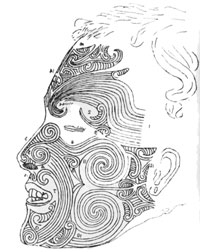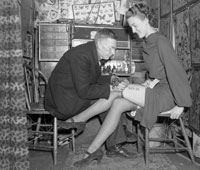History of Tattoos
There are few art forms that have been around for as long as tattooing – in fact, some anthropologists claim that the history of tattoos may date back as long as 15,000 years! Certainly, we know that many of the ancient civilizations, including the Egyptians, Greeks, and Romans, used tattooing techniques. There are mentions of tattooing in the Bible, indicating that it was practiced among the ancient peoples of the Middle East as well. However, the remarkable thing about the history of tattoos is not just the length of time that humans have practiced it; looking at the history of body tattooing, we cannot help but be struck by how widespread this tradition was. Apparently, decorating the body in this permanent way is an almost universal impulse spread over a lot of different cultures.
Tribal Tattoos

A Maori tribal Tattoo
When relating the long history of tattooing, it’s hard to know where to start. Around 2000 BCE tattooing had a cultural significance in places as diverse as China, Crete and Arabia. Among tribeswomen in Borneo, a tattoo on the forearm indicated that woman’s special skills. Among the Maori of New Zealand, intricate tribal tattoo designs had a sacred significance. The Greeks and Romans used tattoos for a different purpose – to show criminal or slave status! This is a concept that we could call the ‘dark side’ of tattoo history – the fact that body tattooing has been used, in certain times in history, to indicate an inferior status. This is relatively unusual and in most cultures, tattoo art is a symbol of status or accomplishment.
The people of the Americas also practiced tattooing – the Maya and Inca people were adept in tattooing techniques, as were the Inuit of Alaska! And, while we may not be accustomed to thinking of Europeans in terms of ‘tribes’, it was not too long ago when the people of Europe were just that – think of the Britons, the Normans, the Goths – and yes, most of these people practiced tattooing as well! However, following the Dark Ages in Europe, the people organized themselves into nations and tattooing became an all-but-forgotten art, only to be rediscovered during the course of eighteenth-century exploration.
The 'New' Tattoo Art
In the early 1700s, the history of tattoos took a new twise. Captain Cook visited the South Pacific Islands and brought back with him an intricately tattooed young girl named Onai. Instantly, tattoo designs became a hit, and many members of the nobility obtained discreet, private tattoo art. For a brief time, tattooing – then a costly, lengthy procedure – became a status symbol. This all changed with the introduction of the first electric tattoo needle in 1891. Suddenly, everyone who wanted a tattoo could have one, and the result was that it came to be considered vulgar. This is, after all, a fairly typical human reaction – when something is hard to get, we tend to want it more!

A woman is having her social security number tattooed
After that, tattoo art went underground, so to speak. A facility in New York’s Chatham Square brought the practice to the modern American public, but tattooing was considered somewhat disreputable until it made a dramatic comeback a few decades ago. As tattoo designs and safety techniques improved, and several prominant celebrities began to sport tattoos, they became desirable once again.
Towards the end of the 1800s criminals in America and even normal citizens were tattooed with a code for identification purposes.
Tattoos Today
Today, we have entered a new phase in the history of tattoos. We could say that the time-honored practice of tattooing has gone mainstream. Today, the procedure is very safe and relatively painless, and there are literally thousands of tattoo designs to choose from. In fact, even a quick internet search for “free tattoo designs” reveals a wealth of cross-cultural designs. In a sense, the whole long history of tattoos is played out in the designs of today, because of the vast number of designs available.